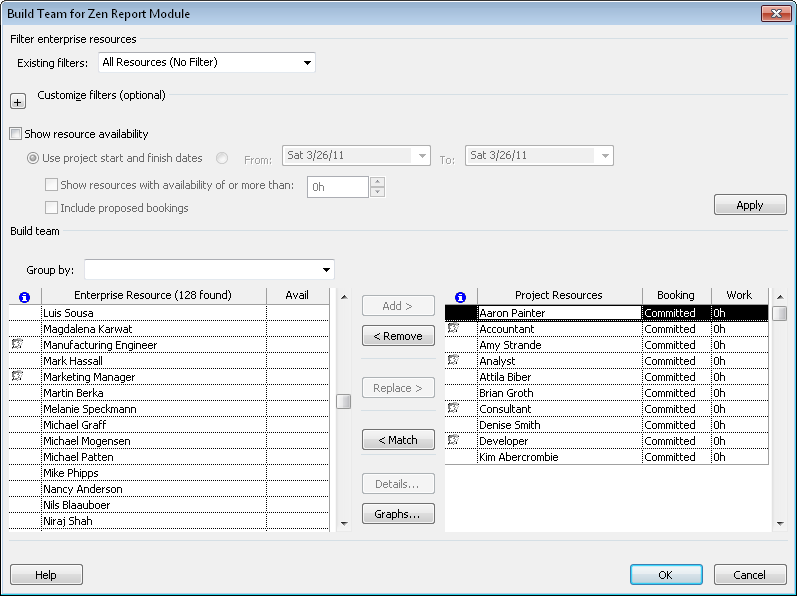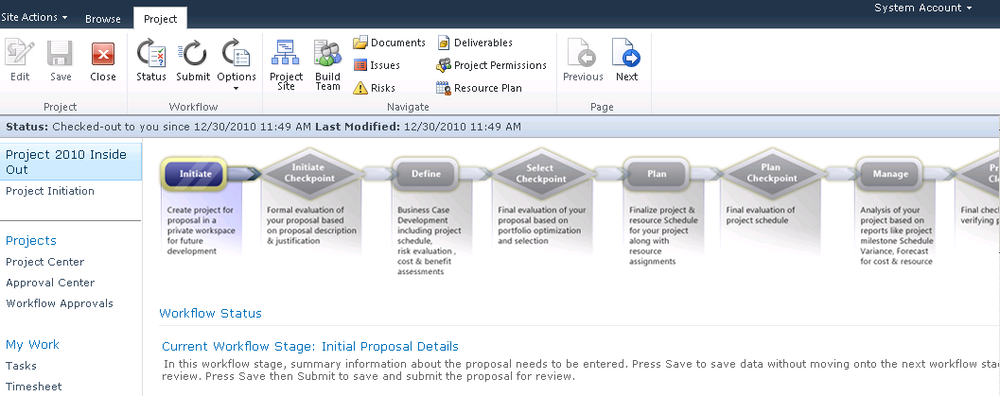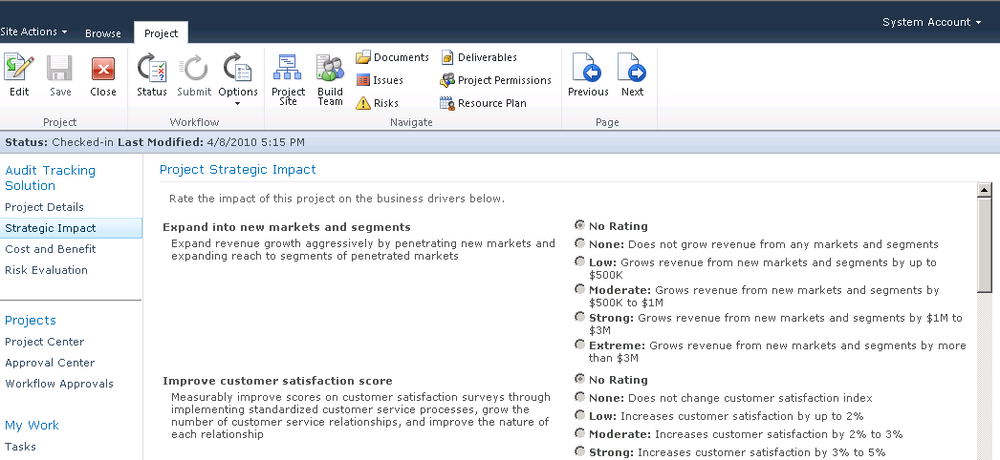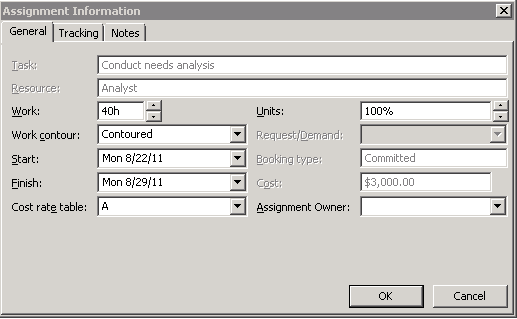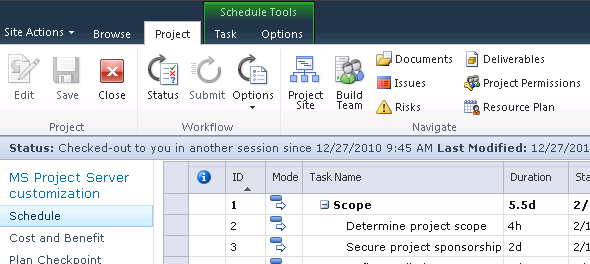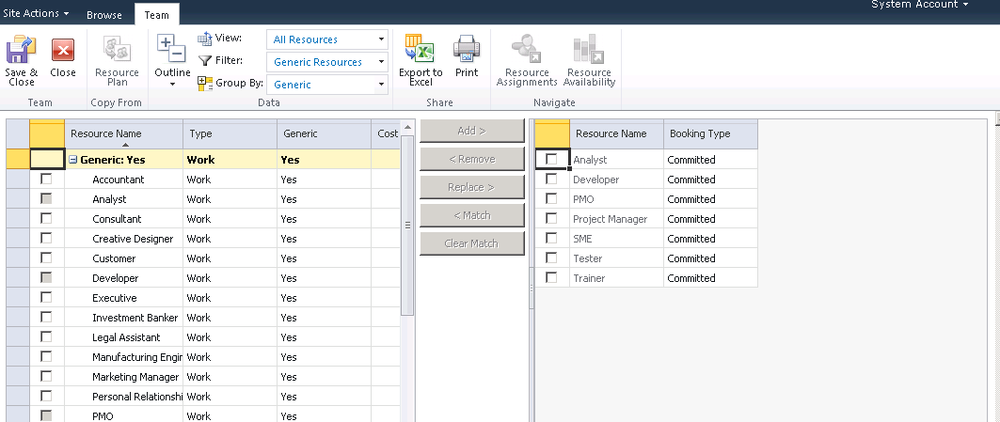Among the advantages of enterprise project management is the capability to work with the enterprise resource pool and its associated functions. The enterprise resource pool is the set of people, equipment, and materials available to be assigned and carry out the work required in projects throughout an organization. It contains fundamental information about resources, such as skill sets and availability, which helps you find the right resources for your projects. The enterprise resource pool also contains cost information, which not only helps you work within your allotted budget but also helps accounting and human resources figure costs from their points of view.
With the enterprise resource pool comes a high level of visibility into resource availabilities, skills, roles, and utilization. Project managers as well as upper management can see when additional staff is needed and where there are underutilized resources. They also can view the basic data for all project resources in one place. Resource managers can also use the enterprise resource pool to staff, plan, and budget with more accuracy and confidence. They can see resources by skill level and definition, availability, and organizational hierarchy. In addition, they can assist project managers with current and anticipated resource requirements by analyzing the enterprise resource database. Together with project managers, resource managers can create and modify generic resources in the enterprise resource pool to perform planning and contingency analyses.
You can have Project 2010 mine the entire enterprise resource pool to find resources that have the exact skills, availability, and other traits you need for your project.
Specifically, in the planning processes of your project, when putting together the perfect team to carry out your project, you can:
Find and add resources by name.
Find resources associated with a certain title, code, skill set, or other attribute.
Use a generic resource as a placeholder.
Add a team assignment pool to your project.
Find resources that are available for work during a certain period of time.
Replace a resource already on your team with another enterprise resource.
Find more resources that have the same traits as a resource already on your team.
Match and replace generic resources in your project with real enterprise resources.
Propose tentative resources to your project.
This section details all these techniques for using the Build Team process to find the right enterprise resources to add to your project.
You might already know exactly which enterprise resources you need to add to your team. If this is the case, you can find and add the resources in Project Professional by following these steps:
Be sure that Project Professional is connected to the project server, and then check out the project to which you want to add resources.
On the Resource tab, in the Insert group, click Add Resources, and then click Build Team From Enterprise.
If there are more than one thousand resources in the enterprise resource pool, a dialog box appears to help you filter the enterprise resources. In the custom enterprise resource field that appears, select a code or other attribute to help define the list of resources you’ll be working with, and then click OK.
The Build Team dialog box appears. (See Figure 24-23.) The upper portion of the dialog box contains filters and options for finding resources that meet certain criteria. The Enterprise Resource table in the lower-left area of the dialog box contains the list of enterprise resources. When no filter is applied, the table lists all members of your organization’s enterprise resource pool. The Project Resources table in the lower-right area of the dialog box lists any enterprise and nonenterprise resources you have already added to the current project.
Figure 24-23. Use the Build Team dialog box in Project Professional to add enterprise resources to your project.
By default, enterprise resources are listed alphabetically by name. You can re-sort the list by clicking the Enterprise Resource column heading.
Scroll through the Enterprise Resource table to find and select a resource by name. You can select multiple resources at once. Use Shift to select multiple adjacent resources; use Ctrl to select multiple nonadjacent resources.
Click Add to add a resource.
The selected resources are added to the Project Resources table.
If you prefer, you can build your enterprise resource team for your project in Project Web App. To add resources in Project Web App, follow these steps:
On the Quick Launch, under Projects, click Project Center.
In the Project Center, click the name of the project for which you want to build your resource team.
At the top of the Quick Launch, under the project name, click Schedule to open the Schedule project detail page.
On the Project tab, in the Navigate group, click Build Team, as shown in Figure 24-24.
On the Build Team page shown in Figure 24-25, select the check boxes next to the resource names you want to add to your project.
The selected resources are added from the enterprise resource pool table on the left to the project table on the right.
When you’re finished using the Build Team page, on the Team tab, in the Team group, click Save & Close.
Custom fields for identifying enterprise resource attributes can be defined by your project server administrator or another user with the proper permissions.
After the custom resource fields are defined, the project server administrator (or other user) associates resources in the enterprise resource pool with the custom resource fields that define those resources. In this way, the enterprise resources are defined by their job code, qualifications, specialties, locations, or any other attributes needed by an organization.
Note
For more information about custom enterprise fields, see Working with Custom Enterprise Fields.
You can use the custom enterprise resource fields to do the following:
Match or replace resources in your project with others associated with the same values in their custom fields. You do this by using the Build Team process.
Substitute generic or enterprise resources in your project with enterprise resources possessing matching values in their custom fields. You do this by using the Resource Substitution Wizard.
Arrange enterprise resources in your project by their custom fields so that you can review your project team by your organization’s resource breakdown structure (RBS) or another resource hierarchy. You do this by sorting, filtering, or grouping by the custom field.
Note
Your project server administrator is responsible for creating your enterprise resource pool and for setting up the custom enterprise resource fields, according to the needs of your organization. For more information, see Creating the Enterprise Resource Pool and Customizing Enterprise Project Fields.
To add a custom enterprise resource field to your enterprise project, follow these steps:
With Project Professional connected to the project server, check out the enterprise project to which you want to add the custom enterprise resource field that has been established for your organization.
Display the Resource Sheet and table to which you want to add the custom enterprise field.
Right-click the column heading next to where you want to insert the custom enterprise field, and then click Insert Column.
In the drop-down list of fields that appears, type the first two letters of the custom enterprise field name to quickly scroll to and click it.
You should know the name of the field from information you received from your project server administrator.
The selected custom enterprise resource field appears in the newly inserted column.
You can use generic resources to help you define resources of a particular role or skill set—for example, Visual Basic Programmer Expert. The project manager can create generic resources.
Generic resources can also be created and added to the enterprise resource pool by the project server administrator or another user with the proper permissions. For best results, an organization should define a generic resource for every classification in its resource breakdown structure. Project managers and resource managers can then use those generic resources in their projects for planning and modeling purposes.
Because generic resources are just placeholders for real resources, they are not associated with any availability status. They can be used in as many projects by as many project managers as needed.
Generic resources are invaluable for helping project managers identify team requirements and ultimately find real resources. Generic resources are typically defined by a job title or function rather than a person’s name. What makes generic resources truly useful is their association with custom enterprise resource fields, which go a long way toward defining the attributes of the resource.
With generic resources associated with custom fields that define resource attributes, you can populate your project team by using the Build Team process.
Note
Your organization might have established a set of generic resources as part of the enterprise resource pool. If this is the case, rather than create your own, use the Build Team process to find the generic resources you want, and then add them to your project team.
If you’re not sure whether generic resources have been defined for your organization, check with your project server administrator, or just filter and browse the enterprise resource pool in the Build Team process.
Sometimes you don’t need to add specific enterprise resources to your project; sometimes you just need a collection of people from a particular department or group to carry out certain tasks. You can assign tasks to the group, and members of the group can assign themselves to the tasks, report on them, and complete them.
This is the idea behind team assignment pools, also known as team resources. A team assignment pool might be a department such as Marketing or a group of individuals doing the same job such as editors.
To find team assignment pools and add them to your list of project resources, do the following:
With Project Professional connected to the project server, open your enterprise project.
On the Resource tab, in the Insert group, click Add Resources, and then click Build Team From Enterprise.
In the Build Team dialog box, click the plus sign next to Customize Filters to expand the section.
Click in the Field Name column of the first row, type te to scroll quickly through the list, and then click Team Assignment Pool.
In the Test column, click Equals.
In the Value(s) field, click Yes. (See Figure 24-26.)
Click the Apply button.
All enterprise resources that are identified as team assignment pools (team resources) are listed in the Enterprise Resource table.
Click a team resource you want, and then click Add to add it to your project resource list.
You can now assign tasks to the team assignment pool.
If you’re looking for a set of enterprise resources that fits a certain set of criteria, you can use the various built-in filters, groups, and other controls in the Build Team dialog box to narrow your search.
To use Project Web App to find and add resources who possess certain attributes, follow these steps:
In the Project Center, click the name of the project for which you want to find resources.
At the top of the Quick Launch, under the project name, click Schedule to open the Schedule project detail page.
On the Project tab, in the Navigate group, click Build Team.
The Build Team page appears.
One of the easiest ways to narrow the enterprise resource pool is to switch to a different view on the Build Team page. On the Team tab, in the Data group, click in the View box.
Typical views for this page include All Resources, Cost Resources, Material Resources, and Work Resources.
To further narrow the list of enterprise resources, apply a built-in filter. On the Team tab, in the Data group, click in the Filter box. On the drop-down menu, click a filter name.
Only those enterprise resources who meet the criteria of the filter are listed in the Enterprise Resource table. This not only reduces your choices to a more manageable level, but it also shows you just the resources that are most useful for your project’s purposes.
If you need to create your own filter based on different criteria than what’s provided, click Custom Filter in the menu.
You can group the resources in the table by a particular resource field. On the Team tab, in the Data group, click in the Group By box, and then click the field you want to group by.
For example, you might find it helpful to group resources by Cost Center or Earliest Available.
The list of enterprise resources is rearranged according to your selected grouping.
If you need to create your own group based on different criteria than what’s provided, click Custom Group in the menu.
Note
For more information about using existing filters and groups, see Rearranging Your Project Information.
To use Project Professional to find and add resources who possess certain attributes, follow these steps:
Be sure that Project Professional is connected to the project server, and then check out the project to which you want to add resources.
On the Resource tab, in the Insert group, click Add Resources, and then click Build Team From Enterprise.
At the top of the Build Team dialog box, click in the Existing Filters box.
Click a filter that will narrow the enterprise resource list the way you need it.
If you need to create your own filter, if necessary, click the plus sign next to Customize Filters to expand the section.
A filter definition table appears.
Click in the Field Name column of the first row, and select the field on which you want to filter.
In the Test column, click the test you want to use, such as Equals or Is Greater Than.
In the Value(s) field, enter the value that should be stored in the field for the resources found by the filter.
If you need to define another set of criteria, in the second row of the table, click in the And/Or field and then click And or Or.
Select the field, test, and value for the second set of criteria.
When you have finished defining the filter, click Save Filter if you want to save it for future use. Otherwise, click Apply.
You can combine the application of your filter with other criteria, including an existing filter or work-availability criteria. When you click the Apply button, the list of enterprise resources changes to show only those resources who meet the criteria of your filter(s).
Creating your own Build Team filter is particularly useful if you want to find resources that are associated with a certain value in a custom enterprise field such as Enterprise Resource Text or Enterprise Resource Number. Likewise, if RBS codes have been set up and applied to enterprise resources, you can filter for a particular RBS code.
Note
For more information about creating filters, see Customizing Filters.
If you find a resource you want to add or replace in your project, you can get more information about that resource’s availability and workload. This can help you decide whether this resource really has the time to work on your project.
To do this, follow these steps:
In Project Center, click the name of the project for which you want to find the resource.
At the top of the Quick Launch, under the project name, click Schedule.
On the Project tab, in the Navigate group, click Build Team.
Select the check box next to the resource name in either the enterprise resource pool table on the left or the project resource table on the right.
On the Team tab, in the Navigate group, click Resource Availability.
You can also get to this graph from Project Professional. In the Build Team dialog box, select the names of the resources for whom you want to see availability graphs, and then click Graphs. The Resource Availability page in Project Web App opens.
Review the availability information.
To switch to a different view, on the Availability tab, in the Views group, click in the View box and select one of the other views; for example, Availability Work By Project, Remaining Availability, and Work.
If you selected multiple resources, you can switch to another resource’s graph by clicking the check box under the graph’s legend.
You can see the resource’s current and upcoming assignments. On the Availability tab, in the Navigate group, click Resource Assignments.
When you are finished reviewing availability and assignment information for the selected resources, on either the Availability tab or the Assignments tab, in the Navigate group, click Resource Center.
You can use the Build Team process in Project Professional or Project Web App to replace a resource on your project team with one from the enterprise resource pool. This step is useful if you have a local resource in the project that you know has been added to the enterprise resource pool.
It is also useful if you want to replace generic resources in your project with real enterprise resources or if you want to replace resources who have the same role.
To replace an existing project resource with an enterprise resource, follow these steps:
In the Build Team dialog box in Project Professional or on the Build Team page in Project Web App, apply the filters or groupings you need to find the replacing resource.
In the Project Resources table on the right, click the name of the resource you want to replace.
In the Enterprise Resource table on the left, click the name of the replacing resource.
Click Replace.
The resource selected in the Enterprise Resource table replaces the one selected in the Project Resources table. If the original resource has reported any actual work on assigned tasks, the original resource remains in the project plan as associated with those assignments. Any remaining work on any tasks assigned to the original resource is now assigned to the replacing resource.
Suppose that you have a resource who has the perfect combination of qualifications for certain tasks in your project, and everything is great—except that you need five more resources just like him. If the existing resource and enterprise resources have attributes defined for them—such as role, RBS codes, skill sets, or certifications—you can use the Build Team process to find other resources who have the same attributes.
To find more enterprise resources whose defined traits match those of an existing project resource, follow these steps:
In the Build Team dialog box in Project Professional or on the Build Team page in Project Web App, apply any filters or groups you need to define matching resources.
In the Project Resources table on the right, click the name of the resource whose traits you want to match to additional enterprise resources.
Click Match.
The list of filtered enterprise resources is searched for resource matches. The resulting list of resources represents resources whose attributes match those of your selected resource.
If you want to add any of these resources, click their names, and then click Add.
You can combine the Match and Replace functions in the Build Team dialog box to help you find enterprise resources to replace generic resources, as follows:
In the Build Team dialog box in Project Professional or on the Build Team page in Project Web App, apply any filters to better focus the list of resources.
In the Project Resources table on the right, select the generic resource you want to match and replace with an actual resource, and then click Match.
Project 2010 finds all the resources in the enterprise resource pool who have the same attributes as the ones you defined for your generic resource. Those matching resources are listed in the Enterprise Resource table on the left.
Select the matching resource who you want to replace the generic resource, and then click Replace.
The matching enterprise resource is added to your project team. If you assigned any tasks to the generic resource, the enterprise resource is now assigned to those tasks.
Repeat steps 2 and 3 to match and replace any other generic resources in your project plan.
As soon as you add enterprise resources to your project team and assign tasks to those resources, their availability information changes in the enterprise resource pool. This availability update ensures, for example, that a single resource is not inadvertently booked full-time for two or three different projects.
Sometimes, however, you need to build a project and its team as a proposal or estimate. You might want to show actual resources in the project to demonstrate the skill level as well as to calculate real costs. However, if the project is just an estimate or model, you probably don’t want to tie up the resource’s availability in case the project does not actually happen.
In another scenario, you might be working with an approved project and want to run a what-if analysis on the impact of adding certain resources to the project.
For either of these cases, you can “soft-book” resources on your project by adding them as proposed rather than committed resources on your team.
Note
The booking type, proposed or committed, applies to the resource as a whole on your project. The booking type does not apply to individual assignments within the project.
By default, all resources are booked as committed. To specify that a resource you’re adding be booked as a proposed resource on your project team, do the following:
In the Build Team dialog box in Project Professional or on the Build Team page in Project Web App, apply any filters or groups you might need to find the resources you want.
In the Enterprise Resource table on the left, click the name of the resource you want to add as a proposed resource.
Click Add.
In the Project Resources table on the right, click in the Booking field for the resource, and then click Proposed.
This resource is now considered soft-booked. As you work through your project, you can choose to consider resources’ booking types when you assign tasks to resources in your project and when leveling assignments to resolve overallocations.
Note
When you’re searching for resources who meet certain availability criteria in Project Professional, you can choose whether proposed resource information should be considered. In the Build Team dialog box, select the Show Resource Availability check box, and then select or clear the Include Proposed Bookings check box.
A resource’s booking type becomes part of the resource information. When you’re ready to confirm a resource’s place in your project, display the Resource Sheet or other resource view. Double-click the proposed resource’s name to open the Resource Information dialog box. On the General tab, in the Booking Type box, change Proposed to Committed.
Once you have built your project team, you’re ready to assign tasks to those team members. You can assign tasks to regular resources, team resources, or generic resources.
In Project Professional, on the Resource tab, in the Assignments group, click Assign Resources. The Assign Resources dialog box appears. Assign your project tasks to the resources in your list.
Note
For more information, see Chapter 8.
To assign resources to tasks in Project Web App, follow these steps:
On the Quick Launch, under Projects, click Project Center.
In the Project Center, click the name of the project.
At the top of the Quick Launch, under the project name, click Schedule to open the Schedule project detail page.
Apply a view that includes the Resource Names column by default. On the Task tab, in the Data group, click in the View box, and then click Tasks Summary, Tasks Schedule, or Tasks Detail. (See Figure 24-27.)
Drag the split bar to the right until the Resource Names column is visible.
Double-click in the Resource Names column.
A list of your team’s resource names appears.
Select the check boxes for the resources you want to assign to each task.
Continue assigning resources in this manner until all assignments are in place, as shown in Figure 24-28.
To periodically save your changes, on the Task tab, in the Project group, click Save. When you’re ready to publish the project with the new resource assignments, on the Task tab, in the Project group, click Publish.
When you assign a task to a work resource, by default that resource becomes the assignment owner—that is, the person responsible for providing progress updates about the assignment. However, what if certain resources do not have Project Web App readily available to them, or for some other reason they can’t provide progress updates? Or, what if the work resource is a piece of equipment?
In such cases, you can identify a different assignment owner. Even though the assigned resource is still responsible for carrying out the assignment itself, the assignment owner becomes responsible for the progress updates on the assignment.
Note
Assignments to material resources and generic resources are owned by the default assignment owner, which is typically the person who created the project plan. That’s probably you. Cost resources do not have assignment owners.
To identify an assignment owner different from the assigned resource in Project Professional, follow these steps:
With Project Professional connected to the project server and your enterprise project open, be sure that the resource has been assigned to tasks.
Open one of the two assignment views: Task Usage or Resource Usage. To do this, click View, Task Views, Task Usage or View, Resource Views, Resource Usage.
Double-click the assignment for which you want to designate a different assignment owner. In the Task Usage view, the assignment is the resource name under the task name. In the Resource Usage view, the assignment is the task name under the resource name.
The Assignment Information dialog box appears, as shown in Figure 24-29.
On the General tab, in the Assignment Owner box, select the name of the resource to be responsible for submitting status updates for this assignment.
All enterprise resources added to this project, as well as the project manager who originally published this project, are listed as possible assignment owners.
In Project Web App, the assignment owner receives the assignment information and the reminders to submit updates and status reports on this assignment.
Each work resource has a default assignment owner. Typically, that default is the resource himself. Otherwise, the default assignment owner is the project manager who generated the current project. The default assignment owner for any enterprise work resource on your project team can be changed by the project server administrator or another user with the permission to edit enterprise resource information.
Although you cannot change the default assignment owner, in Project Professional you can see who it is on the General tab in the Resource Information dialog box. Likewise, in Project Web App, you can see assignment owners for each task by applying the Assignments Tracking view to the Schedule page.
The project server administrator can change the default assignment owner in the Resource Center. Select the check box next to the resource name, and then on the Resources tab, in the Editing group, click Edit Resource. The Default Assignment Owner field is available in the Assignment Attributes section.
The flip side of the assignment owner is the status manager. Just as a resource needs to be responsible for submitting status information about an assignment, another person needs to be responsible for receiving that status information. That person is the status manager.
The default status manager for a task is the person who originally published the task to the project server. There can be different status managers for different tasks. To see or change the status manager for tasks, add the Status Manager field to a task sheet in Project Professional as follows:
With Project Professional connected to the project server and your enterprise project open, switch to a task sheet such as the Gantt Chart.
Right-click the column heading next to where you want to insert the Status Manager field.
In the shortcut menu that appears, click Insert Column.
In the drop-down list that appears, type stat to quickly find and click the Status Manager field.
The Status Manager field appears in the newly inserted column.
To change a status manager for a task, click in the field, and then click the arrow. In the list of status managers for the current project, click the status manager you want for this task.

